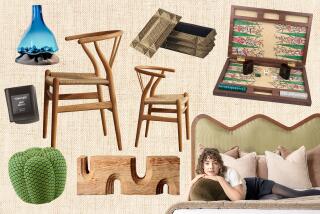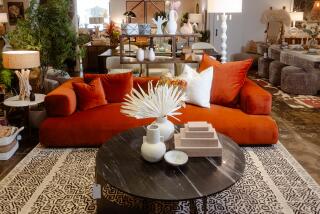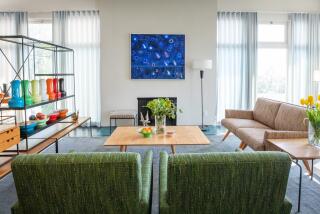Carving a legacy
SHIRLEY NYQUIST, the vivacious record-keeper of her husband’s furniture-making business, pulls out a typewritten list from 1960 showing a walnut armchair with sculpted back and upholstered seat priced at $125. And today? That same chair would be $4,500.
John Nyquist may not be a top name, but his made-to-order furnishings command top dollar. The Long Beach woodworker has hand-built his legacy among aficionados of midcentury design for almost 50 years. Look to the current vogue for solid wood tables and chairs from contemporary manufacturers such as Thos. Moser, and one can’t help but see Nyquist’s influence. Yet because his own furniture has never been mass-manufactured, Nyquist’s relatively scarce output remains catnip largely for 20th century design junkies. In May, the auction house Wright sold a single 1960s ladder-back chair by Nyquist for $7,200 -- confirmation that his work has joined the canon of West Coast crafts.
The true test of a good design, of course, is not how much it costs, but how long it endures.
“You have fads that go in and out, but John Nyquist’s style has been unchanged for decades,” says Ron Frank, the second-generation owner of Long Beach-based Frank Bros., known as a proponent of post-World War II California and Danish modern design before the store closed in 1982. “He never made a shape that didn’t serve a purpose. He is a connoisseur, using design to bring out the qualities of fine woods.”
Nyquist, 72, puts it simply: “Once you solve the problem of how a piece must function, let the wood speak for itself.” Rather than clutter the wood with embellishment, he says, showcase its pattern or unusual color. “I love to look at it and decide the best way to use it and shape it, to turn it into something one of a kind.”
Like Sam Maloof and the late Arthur Espenet Carpenter, Nyquist became an adherent of the “California roundover” movement that was pioneered by Charles and Henry Greene and characterized by how woodworkers sculpted the edge of a tabletop or the arm of a chair. The look conjoined organic and architectural forms, “where hard right angles are softened by curved and sloping lines, like the flirty outward kick of a chair’s back legs,” says Jo Lauria, museum consultant and author of “California Design,” which documents the landmark furniture and decorative arts of the 1950s, ‘60s and early ‘70s.
Nyquist’s work also is defined by impeccably crafted parts, often done in contrasting woods, and exposed joinery.
“The wood just glows, and that’s because of his careful sanding, polishing and finishing, which is an art form in itself,” says Anthony Fortner, a Nyquist protege who’s a woodworking professor at Cerritos College.
Another Nyquist hallmark is the lack of shiny varnish. Nothing separates the wood from your touch, Frank says. “It is not furniture that screams at you.”
Indeed, Nyquist’s style lends grace to the implements of daily living, Lauria says. “It’s humanistic, yet its sophisticated design gives it a modernist, high-style spin that makes it feel at home in such disparate interiors as Arts and Crafts and contemporary.”
The exquisite Asian-influenced craftsmanship of Greene & Greene’s 1908 Gamble House had a profound effect on Nyquist, who acknowledges other influences in his work: the elemental quality of Shaker furniture, the swank shape of Scandinavian modern and the voluptuous forms of sculptor Henry Moore.
NYQUIST WAS born in 1936, the son of a first-generation Swedish American, and raised near Mt. Rushmore in South Dakota. The family’s first home was a log cabin with no electricity, Nyquist says. “Then we moved into a modern one with running water.”
After serving in World War II, his father, vowing never to be cold again, moved the brood to Long Beach. Nyquist studied art and industrial design at the California State University campus there and was introduced to a now-defunct group called Southern California Designer Craftsmen.
He found early clients through architects, construction firms and private patrons who saw his work in the “California Design” shows, 13 influential exhibitions at the Pasadena Art Museum, now the Norton Simon.
From the outset, Nyquist favored exotic materials such as Brazilian rosewood and Makassar ebony that arrived at the local port. For upholstery, he still uses richly colored wool fabric by Jack Lenor Larsen. “John even used leather from Connolly, a British firm that did the interiors of Rolls-Royces and Jaguars,” L.A. store owner Sam Kaufman says. “Which is quite appropriate, since he is obviously an aesthete and his work has the classic curves of luxury motor cars.”
Today, offshore production and cheap buys at big-box stores don’t faze Nyquist, who still crafts each design, piece by piece, all by himself.
“We’re not a dying breed, but our clientele has changed a lot over the years,” he says. “They’re further and fewer between, but they do like to spend the money if they have it.”
What clients get in return, Fortner says, is something they can’t buy in most stores. “It’s made in Long Beach. You can smell the sea and the salt air and get to know the man with the hands and smile who designed and built this furniture, who takes your measurements and makes the host and hostess chair different sizes to fit each one perfectly,” Fortner says. “It’s a relationship that cannot happen with mass-production furniture.”
Despite a recent four-year, six-figure commission that included a 14-foot dining table with 14 matching chairs, Nyquist’s proudest achievement just might be his home.
From the street, the residence appears modest, a three-bedroom house with a large picture window. Look through the glass, however, and there stands a small museum of Nyquist tables and chairs -- prototypes that date back half a century as well as recent pieces. Were it not for the decoy ducks and tabletop photos of six kids and 11 grandchildren, the home could pass as a showroom for his work.
The mahogany front door has stained glass panels that he designed, a decorative motif that repeats in a four-panel stained-glass tree in the master bathroom. The ceramic mailbox by Frank Matranga has a lid that Nyquist carved from teak.
In the foyer, Chinese soldier figurines sit on a wall-mounted console made from long leaf maple and equipped with rosewood drawers. Across from it sits a massive stoneware Totem sculpture by Elaine Katzer, a Nyquist jewelry box lined in hot pink felt and a George Nakashima Conoid chair given to him upon his retirement as a teacher at Cerritos College.
As part of a substantial renovation, Nyquist built Shinto shrine-inspired fences in the yard and installed cherry cabinets in the kitchen. He lined some rooms with tongue-and-groove red oak planks that run horizontally, giving them the appearance of a closed tambour on a roll-top desk.
There are slab-top side tables, spindle-back rockers, upholstered lounge chairs with matching ottomans and a glass-top coffee table with a carved base clad in leather. All bear the imprint of a “J” stacked on top of an “N” to create a hieroglyph of a chair.
Nyquist says he can complete one chair a week, to which his wife teases, “Yes, if you just stick with one chair.”
The beauty of his job, the craftsman says, is that he doesn’t have to.
“Nothing goes from beginning to end in one session,” he says. “I don’t have a wristwatch and there’s no clock in the wood shop. When it’s dark outside, then I go home.”
--
--
WEB EXTRA: VIDEO
John Nyquist may start with simple boards of white oak, but after one week he’ll emerge from his Long Beach studio with the most graceful of rocking chairs, each spindle in the back shaped just so. For a closer look at that process, check out David A. Keeps’ video posted online with additional pictures of Nyquist’s home, filled with half a century of classic craftsmanship. These bonus features can be found with this article at latimes.com/home, as well as in a special index with all the profiles from this series to date, at latimes.com/mastersofcraft.
More to Read
Inside the business of entertainment
The Wide Shot brings you news, analysis and insights on everything from streaming wars to production — and what it all means for the future.
You may occasionally receive promotional content from the Los Angeles Times.










